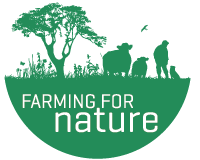John Robinson
John Robinson along with his wife and family, run a mixed organic farm in county Sligo. He runs about 10 horned mountain sheep and 25-30 suckler cattle. The farm is full of diversity when it comes to animal species, along with the cattle and sheep there are pigs, hens, guinea hens, ducks, geese and 5 beehives.
The land is mixed – some good permanent pasture grassland and some marginal hilly land. The animals graze in a paddock grazing system in the lower land and they then venture upwards where they graze the diverse variety of plants and grasses on the hill. Haylage is cut off the land and fed over winter. External inputs on the farm are extremely low.
Johns low-impact farming system is reflected in the diversity of plants and trees, as well as the array of wildlife on the land. Wildlife species on the farm include pine martin, foxes, hares, red squirrel, fallow deer, buzzards and more. A pond was dug on the land which has increased the biodiversity on the farm immensely – from dragon flies to frogs to the occasional wild duck. Trees have been planted all around the farm – beech, oak, spindle guelder rose and strawberry trees. John and his family have built a farm that works with the natural landscape and ecology of the land, all the while ensuring the livestock enterprise pays for itself.
Nomination Description:
Lugnamackan just outside Collooney in Co. Sligo can only be described as the side of a mountain… but it is the right side of the mountain.
In one way Lugnamackan could be perceived as a hobby farm, as John’s principal income comes from his work as a vet and he spends a lot of his CAP payments on landscaping projects like dry stone walls and ponds that most farmers would regard as follies. But John makes a clear distinction between his stewardship of the land and the farming enterprise that is part of it - “the livestock that lives here must pay their way”.
The livestock species range is impressive; there are hens, ducks, occasional turkeys, goats, pigs, sheep, cattle and bees. The farm itself does not cover a vast area, but it is complex enough for a visitor to get properly lost. The fields are small, tiered, and heavily embossed with the remnants of agricultural history. The range of plant species shift with the elevation, and the amount of flowering plants is startling.
The flow of water in the limestone is mysterious as it disappears into the ground to reappear as a random spring a few hundred metres away. John has intervened and added two large ponds to the network. It is a potential reservoir, water source for cattle and wildlife habitat.
The lower elevations of the farm are tree rich, part of the extensive mountain land runs down into an incredible wild hazelwood. John fitted a few of the matriarch cows with Swiss cowbells so he can find the herd when they are browsing in the trees.
The bees are situated in the rejuvenated an old orchard that John has extended by adding more heritage apple trees. He has lined the lanes on the farm will and multitude of lesser-known native trees and shrubs like guelder rose and spindle and strawberry tree.
What makes this farm interesting is, despite its low productive output, John manages it to the natural capacity of the land, with care and consideration of all the habitats. He has learned the best times to put animals on the mountain, to graze wildflowers and grasses after they have seeded to replenish the diverse bounty for the bees next year. Well-timed grazing on the mountain, especially with the sheep and goats impacts the heather creating a diversity of cover by staggering stages and height of growth. He uses the hazelwood to shelter the animals in stormy weather, the bottom fields when they are dry in summer and the good ground to save hay and silage and as a buffer when the other areas need recovery time. The result is true stewardship, learned and still learning through keen observation. It may not be intensive or produce a high volume, but was is produced is at a profit, all while sensitively managing a high nature value landscape without exploiting it.
Nominator: Clive Bright, FFN Ambassador





